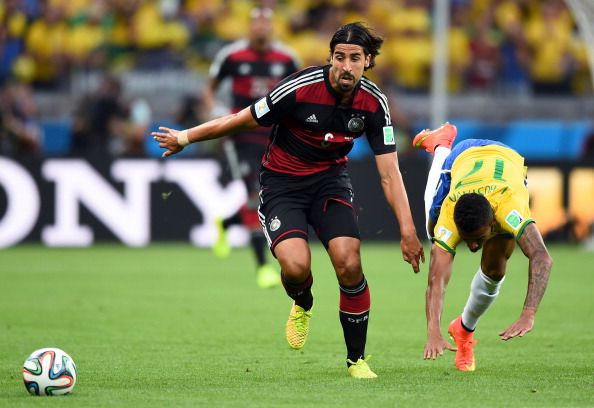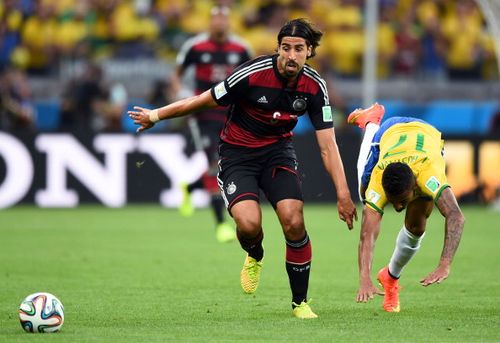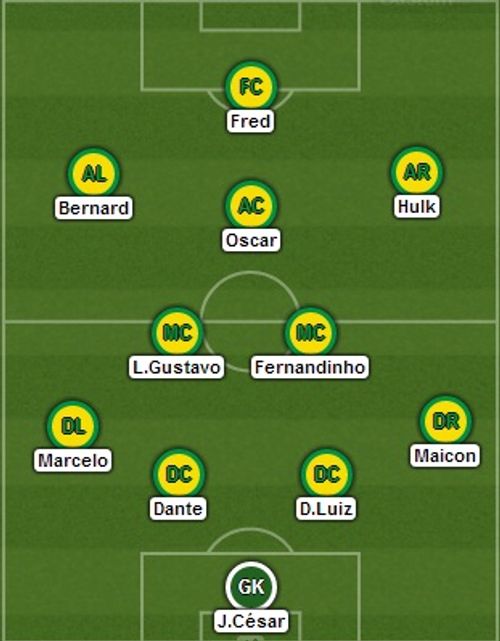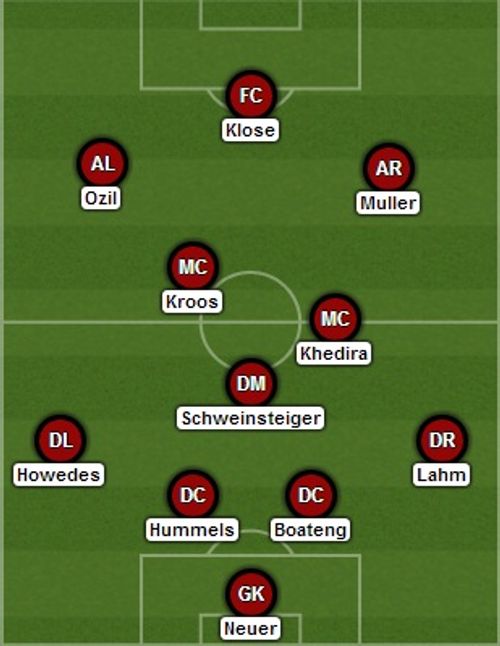
FIFA World Cup 2014: Brazil 1-7 Germany - Tactical Analysis

What was supposed to be a tight, tense affair turned into the highest scoring game of this edition of the World Cup as Germany thrashed Brazil 7-1. In the absence of Neymar, Brazil didn’t pose too much of an offensive threat, but they lost primarily because of their inability to defend. Here is a look at how both teams approached the game tactically and where the game was won and lost.
Brazil’s tactical set-up

In the absence of Neymar, coach Scolari went with the hometown favourite Bernard to help create something in attack. The diminutive winger, much like Neymar relies on trickery and deception to get past his full back, who, on this occasion happened to be the ever-dependable Phillip Lahm.
Apart from Luiz Gustavo coming back from suspension in place of Paulinho, Brazil had to make another change at the back with captain Thiago Silva suspended. Bayern Munich’s Dante came in for the skipper and filled in at centre back.
In Gustavo and Fernandinho, Brazil had two powerful, physical players who could not only win the ball, but also move forward with it. It was billed as the clash between the aggressive and physical Brazilian duo against the more technical trio of Kroos, Khedira and Schweinsteiger.
Germany’s tactical set-up

Joachim Löw on the other hand, had no injuries or suspensions to worry about and started with the same line-up that saw off France. It was a 23rd World Cup appearance for Klose who started up front as the main striker with Thomas Müller on the right and Mesut Ozil on the left.
In midfield, it was the trio of Schweinsteiger, Khedira and Kroos patrolling the centre of the park and providing with both an offensive and defensive threat. The former was to sit in front of the back four and mop up anything that comes his way, while Khedira and Kroos were given the license to join in on the attack at every opportunity.
At the back, Lahm once again started at right back, providing some much needed solidity, while Hummels and Boateng were the two centre backs, which meant that Mertesacker was on the bench yet again.
Early exchanges
If there was one thing that was very evident early on in the match, it was that Brazil proceeded to shed the air of caution that surrounded their play so far and opted a more gung-ho approach. Attacking this German side right from the start isn’t a wise thing to do, especially considering the pace with which they can break and exploit open spaces. But all of it would’ve been worth it Brazil got an early goal like they did in their previous two knockout matches.
Instead, the first warning sign came from Germany. After just five minutes, the hitherto conservative Marcelo, who had done a good job on not straying too far forward, started with gay abandon and that spelled doom. Even though the hosts had Luiz Gustavo to fill in if needed, he was of no use when Thomas Müller sprinted past Marcelo into oceans of space as Miroslav Klose received the ball with his back to goal. Fortunately for Brazil, Klose didn’t spot the run and Müller was left fuming. However that was one of the few occasions in the 90 minutes when Marcelo was left scot-free.
Opening goal and the rout that followed
Barely five minutes later, Marcelo once again went forward but this time lost the ball carelessly and the two central midfielders in Kroos and Khedira combined to great effect down their right flank. But before something could come of it, Marcelo was back and conceded a corner. It was that corner from which Müller scored Germany’s opener. After the goal, the left-back apologized to his minutes, but that did nothing to stop the Germans from piling the pressure on him.
In the opening half hour, every single German attack seemed to start on their right flank and Marcelo, who didn’t have proper help from his teammates, struggled to cope with the relentless German onslaught. Klose’s 16th World Cup goal came on 22 minutes, after Müller and Lahm combined effectively before Müller drifted inside and teed up Klose. The third goal also arrived from the right flank, but this time it was Lahm who set up Kroos for the easy finish. Lahm was at it again in the second half, when he collected his second assist of the game when he set up substitute André Schürrle for the sixth goal.
But, by the time the third goal went, Brazil were done and dusted. And in the blink of an eye, their disjointed defence was once again split open once again as Fernandinho was tackled off the ball by Kroos, who played a one-two with Khedira before slotting home his second World Cup goal in as many minutes. The fifth was almost a carbon copy of it, only this time, it was Hummels who stepped forward to dispossess Fernandinho and it was Khedira who scored.
What started as a battle between two midfields, turned into a very one-sided affair as Khedira and Kroos did what Fernandinho and co. did to Colombia, only without being overtly physical and resorting to rough-house tactics. In a way, they beat Brazil at their own game by getting in their faces and not letting them have a moment’s respite.
And just like that, Germany were 5-0 up inside 30 minutes, without having to do anything extraordinary. Their high-defensive line coupled with their midfielders pressing and not letting Brazil pass meant that the Germans had the upper-hand. The fact that they came up against Fred, a striker who didn’t have the power, pace or the ability to offer an out-ball meant that Neuer could sweep with a lot more confidence and a lot less to worry about.
With their midfield stifled and without a proper out-ball, Brazil’s only attacking threat was David Luiz. When the central defender’s long balls were of little use, he started his forays forward and in doing so, left the defence exposed and start the vicious cycle of German attack all over again. The half-time whistle couldn’t have come at a better time for Brazil who were outclassed and outplayed by the pro-active Germans.
Brazil’s early second-half pressure
The introduction of Paulinho and Ramires for the ineffective Hulk and Fernandinho had the desired impact at the start of the second-half. Brazil looked like an attacking threat for the first time in the match and started showing glimpses of a fight-back. Even the marginalised Bernard came into the game and started whipping in some delightful crosses.
Unfortunately for Brazil, they met with a keeper in fine form and had a striker who was woefully out of form. As a result, Brazil were unable to capitalise on their chances and before they knew it, Germany hit a sucker punch by scoring the sixth goal.
Return to status quo: German domination
Once Schürrle scored it was back for square one for Brazil as the hosts tried ever so hard to keep the score line in single digits. If it weren’t for some heroics from Julio Cesar and some profligate finishing from the Germans, it could very well have been the biggest victory in World Cup history.
Conclusion
Before the game started, it was billed as a clash of two different styles: the physical approach of the hosts against the more technical and refined approach of the Europeans. Instead what transpired was not just a defensive capitulation by Brazil, but also some brilliant pro-active football by the Germans who knew Brazil’s weakness and exploited that.
While Brazil didn’t help their own cause by going all out to attack, when they would have been better off sitting deep, even if they did, such was the gulf in class between the two sides that there was only ever going to be winner. And the man who led Germany into their eighth World Cup final is someone who exemplifies the modern German midfielder: an all-rounder who can not only play precise penetrative passes, but can also be physically imposing when the situation demands.